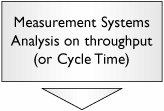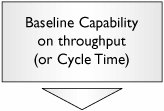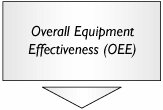B. Capacity of Process Is Too Low Overview Processes are required to cycle at a fast-enough rate to generate entities at a pace to meet customer (or market) demand. If the process capacity is too low, the process isn't cycling quickly enough and will inevitably fall behind or won't be able to meet spikes in demand when they occur. It is useful to ask the question before proceeding as to why this low capacity is a problem. If the answer relates to failure to meet delivery to Customers, revert to Section A in this chapter before following the approach outlined here. Examples Industrial. Plant/line throughput Healthcare. Emergency department/surgery throughput Service/Transactional. Service center capacity
Measuring Performance In considering capacity of a process, typical primary measures would comprise Both metrics effectively achieve the same result; however, it sometimes is useful to describe the problem in both formats to better explain to Team members the implications of the problem. Tool Approach If not already done in a previous step, commence with |  | Focus should just be on measuring validity (a sound operational definition and consistent measure) of the metric versus a heavy investigation of Gage R&R. For more detail see "MSAValidity" and "MSAContinuous" in Chapter 7. | |  | This could be as simple as identifying how many entities the process generated over the period of, say, one month and calculating a throughput rate from that. For more detail see "CapabilityAttribute" and "CapabilityContinuous" in Chapter 7. |
If the throughput of the process is still deemed to be too low, continue with |  | The process would hit maximum capacity if it were running all of the time only doing value-added (VA) activity and if it were running as fast as it has ever run and if it were generating perfect quality entities. |
From the OEE, we should have gained an understanding of whether the issue is either |  | This is a quality-related problem. Capacity is effectively lost because the process spends time generating defective entities. Continue to Section C in this chapter. | |  | Capacity is effectively lost because the process is spending part of its available time to do VA entity generation doing something else. Continue to Section D in this chapter. | |  | Capacity is effectively lost because the process could do the VA work more rapidly. Continue to Section E in this chapter. |
| 




